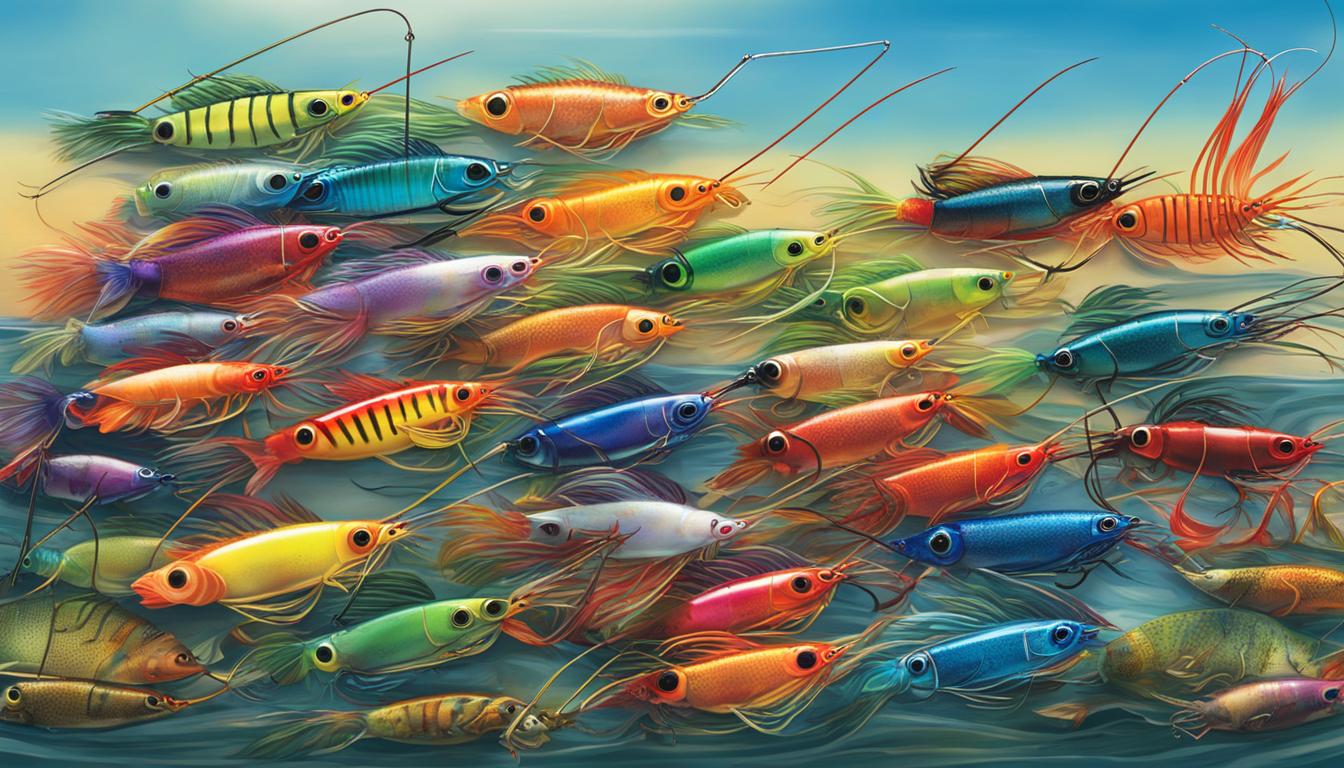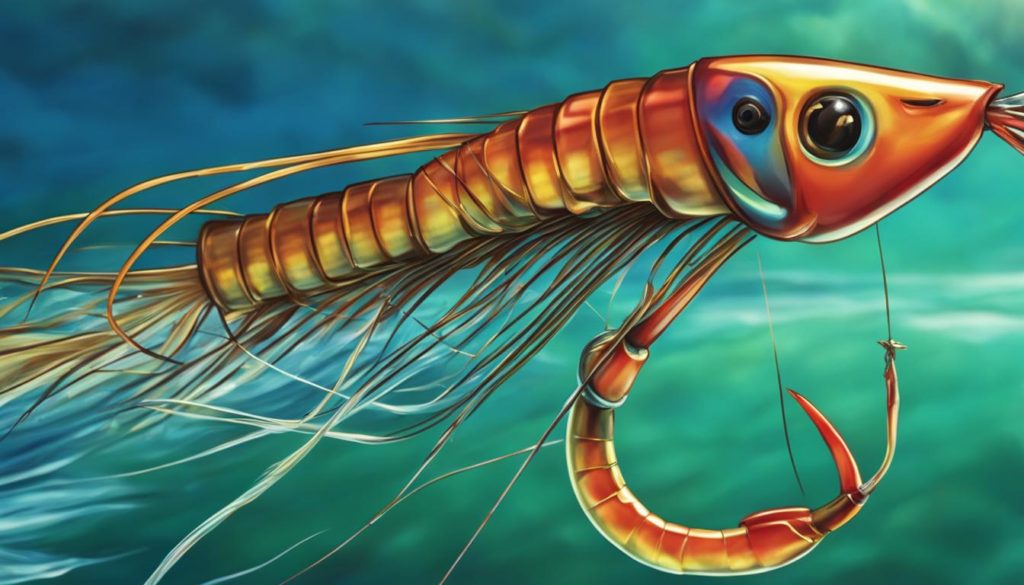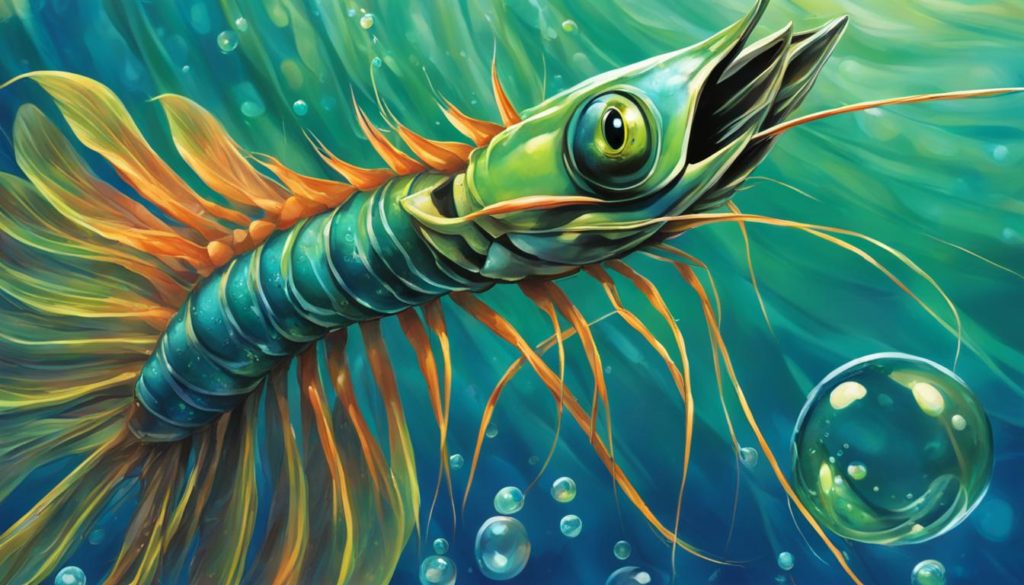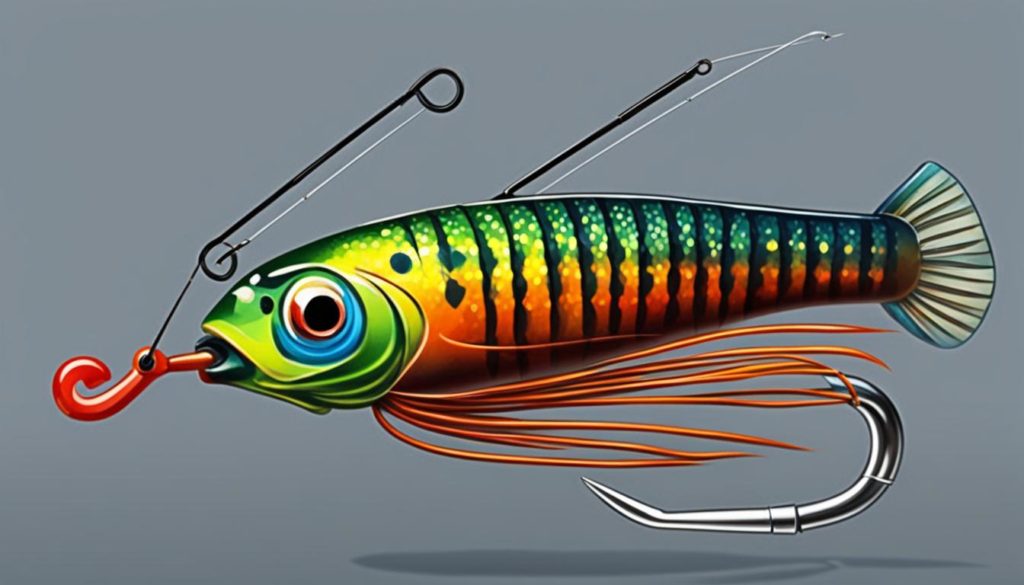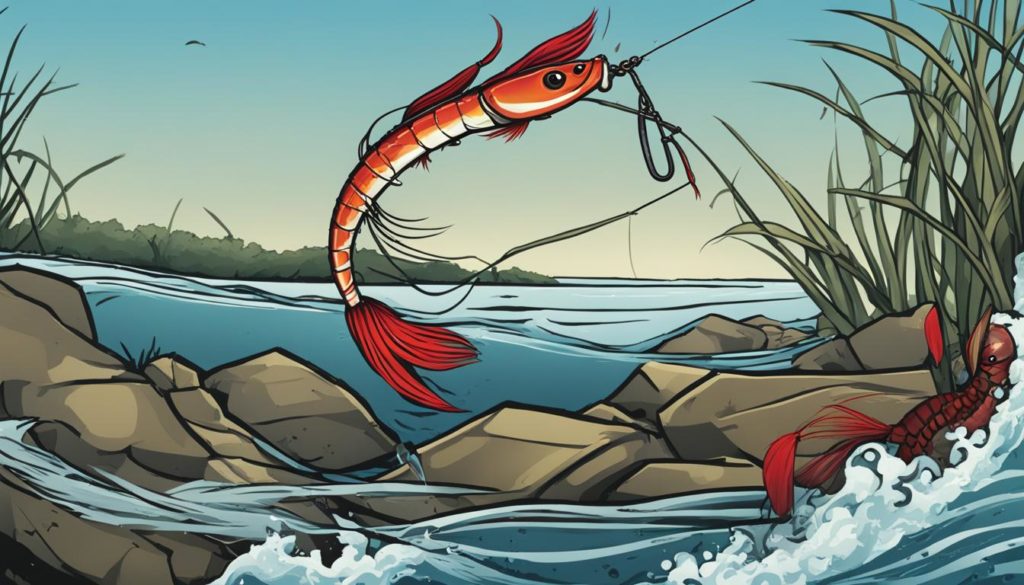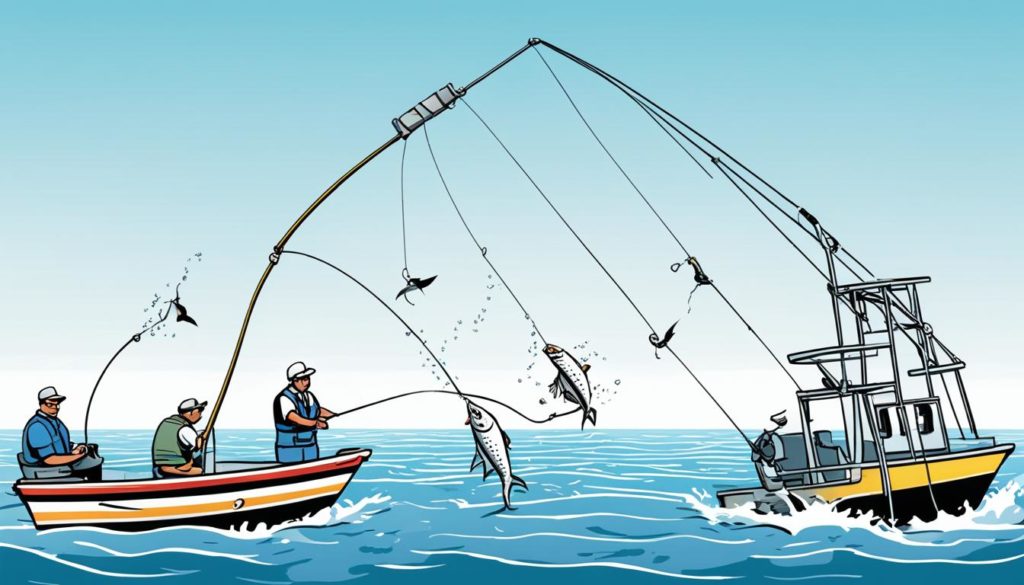Live shrimp rigs are essential for successful saltwater fishing. In this article, we will explore the top 5 live shrimp rigs that offer the best performance and results. These rigs have been carefully selected based on their effectiveness in different fishing scenarios and their ability to attract a variety of saltwater fish species.
Key Takeaways:
- Live shrimp rigs are crucial for saltwater fishing success.
- The top 5 live shrimp rigs offer excellent performance and results.
- These rigs are effective in various fishing scenarios and attract a wide range of saltwater fish species.
- Experiment with different rigs to find the most effective setup for your saltwater fishing adventures.
- Stay tuned to learn about each rig in detail and how to use them for optimal results.
Live Shrimp on a Jig – Perfect for Drifting
One popular live shrimp rig is using a jighead to secure the shrimp. This rig is ideal for drifting inshore fisheries and can attract a variety of fish such as seatrout, redfish, snook, and snappers. By using a light but sturdy jighead, you can ensure that the shrimp remains lively and responsive to predators. This rig is particularly effective when fishing back to structure like docks or bridge pilings and can also be used with popping corks for added casting distance.
When using a live shrimp on a jig, the jighead’s weight allows you to control the depth and speed of your presentation while drifting. This is especially beneficial when targeting inshore fisheries where these species are commonly found. The combination of the live shrimp’s natural movement and the jighead’s enticing action makes it an irresistible meal for seatrout, redfish, snook, and snappers.
Whether you choose to drift near structures like docks and bridge pilings or out in the open water, the live shrimp on a jig rig provides versatility and effectiveness in attracting a wide range of fish. Its ability to mimic the natural movement of shrimp and the visual appeal of a jig make it a go-to rig for many anglers in inshore fisheries.
For added casting distance, you can also pair the live shrimp on a jig rig with popping corks. The popping cork creates an enticing noise and disturbance in the water, grabbing the attention of nearby fish. By mimicking the sound and movement of feeding fish, the combination of a live shrimp on a jig and a popping cork greatly increases your chances of attracting fish.
Next, we’ll explore another live shrimp rig that is perfect for casting and sight fishing: the tail hooked shrimp rig.
Tail Hooked Shrimp – Perfect for Casting
When targeting fish that require casting, the tail hooked shrimp rig is an excellent choice. This rig ensures maximum casting distance and accuracy, allowing you to reach your desired fishing spots. By hooking the shrimp through the second to the last segment of its abdomen, with the hook point poking out of the ridge of the back, you create a balanced setup that minimizes spinning during both casting and in-water action. The tail hooked shrimp rig is particularly effective for sight fishing, where precision and natural presentation are crucial.
In this rig, the shrimp is free to swim naturally, making it incredibly enticing to various saltwater species, including the sought-after snook. Casting a bait into a docklight for snook, for example, can yield excellent results with a tail hooked shrimp rig. The shrimp’s realistic movement, combined with the irresistible scent it emits, proves irresistible to snook and other gamefish.
To further enhance its effectiveness, consider combining the tail hooked shrimp rig with other techniques like drifting. By allowing the shrimp to move with the current while keeping it in the strike zone, you increase your chances of enticing a hungry fish to bite.
As with any rig, it’s essential to vary your retrieval speed and presentation technique to find what works best for the specific conditions and fish you’re targeting.
For a visual reference, take a look at the image demonstrating the tail hooked shrimp rig:
Tail Hooked Shrimp Rig
| Components | Description |
|---|---|
| Shrimp | Live or frozen shrimp, preferably tail-on |
| Hook | Appropriate-sized hook for the shrimp |
| Weight | Optional – use a weight to help the shrimp sink or adjust presentation |
| Leader | Fluorocarbon or monofilament leader to connect the hook to the mainline |
Remember to adjust the size of the hook and weight according to the size of the shrimp and the targeted species. Experiment with different sizes and colors to see what entices the fish in your area most effectively.
Texas Rig – Ideal for Weedless Fishing
The Texas rig is an excellent choice for situations where a weedless presentation is necessary. This rig allows you to conceal the hook in grass and debris, making it ideal for targeting redfish and other species that often inhabit grassy areas.
To set up a Texas rig, you’ll need an inline J-hook. First, pinch off the tail of the shrimp, creating a point of entry for the hook. Thread the hook into the abdomen and bury the point into the shrimp’s body. This rig provides a completely weedless and castable live shrimp that remains active in the water and gives off a natural scent.
Bucktail with a Bite – Adding Extra Attraction
Looking for a way to give your bucktail jig an extra edge? Try adding a piece of shrimp to it. This simple technique can significantly enhance its effectiveness and increase your chances of hooking a trophy fish. By combining the vibrant colors and enticing action of the bucktail jig with the natural scent and appearance of shrimp, you create a irresistible presentation that fish find hard to resist.
To incorporate the shrimp into your bucktail jig, start by snipping off the tail of a fresh shrimp. Then, thread the shrimp onto the hook of your bucktail jig just as you would with a soft plastic bait. The key is to ensure that the shrimp is securely attached and positioned in a way that allows it to move freely and realistically.
The combination of the bucktail jig and shrimp creates a dynamic duo that produces extra attraction and entices even the most lethargic fish to bite. The bucktail jig provides enticing movement and attracts attention, while the shrimp offers a natural scent and lifelike appearance that fish find irresistible.
This rig is particularly effective when bouncing deep holes, especially during times when fish are less active and need extra stimulation to bite. Whether you’re targeting species like snook, redfish, or grouper, adding a piece of shrimp to your bucktail jig can give you that added advantage and improve your chances of success.
When using the bucktail with a bite rig, it’s important to experiment with different retrieves and depths to find the most effective presentation for the day. Vary your retrieve speed, pause, and twitch the bait to mimic the behavior of a wounded or fleeing shrimp. Pay attention to the fish’s behavior and adapt your technique accordingly.
So, the next time you head out for a saltwater fishing adventure, don’t forget to add some extra attraction to your arsenal with the bucktail with a bite rig. It could just be the secret weapon you need to hook that trophy fish!
Two-Hook Bottom Fishing Rig – Versatile and Effective
The two-hook bottom fishing rig is a versatile and effective rig that can be used to catch a wide range of saltwater fish species. This rig consists of an arm’s length of 30- to 50-pound monofilament with four 2- to 3-inch dropper loops spaced 3 to 4 inches apart. Attach a sinker to the bottom loop and a hook to each of the two middle loops. This rig is ideal for both small pan fish and larger grouper. It allows for easy customization by dressing up the hooks with attractants like bucktail hair, beads, spinners, or floats.
Three-Way Saltwater Fishing Rig – Simple and Effective
The three-way saltwater fishing rig is a simple yet effective rig that utilizes a three-way swivel. This rig is perfect for drifting, trolling, or dropping to the bottom, allowing the bait or lure to hover just above the bottom and enticing fish to strike. Whether you’re a beginner or an experienced angler, the three-way rig is a versatile option that can be used with both artificial and natural saltwater bait.
To set up the three-way rig, follow these simple steps:
- Tie a short piece of leader line to one eye of the three-way swivel.
- Tie a longer piece of leader line to the other eye of the swivel.
- Attach a sinker or jig to the short leader line.
- Attach a hook or lure to the longer leader line.
The three-way rig offers several advantages over other fishing rigs. Its simplicity makes it easy to set up and use, making it suitable for anglers of all skill levels. The one-hook configuration reduces the risk of tangles and snags, ensuring a smooth fishing experience. Additionally, the three-way rig is highly versatile and can be used for various fishing techniques, including drifting, trolling, or dropping to the bottom.
Drifting the three-way rig allows you to cover a large area of water, increasing your chances of hooking into fish. The bait or lure hovers just above the bottom, attracting fish that are feeding in the mid-water column. This technique is particularly effective when targeting species like striped bass, bluefish, and flounder.
Trolling with the three-way rig is another popular technique for saltwater fishing. By adjusting the length of the leader line, you can control the depth at which the bait or lure runs, targeting specific species that are feeding at different depths. This technique is commonly used for targeting pelagic fish like tuna, mahi-mahi, and king mackerel.
In addition to drifting and trolling, the three-way rig can also be dropped to the bottom when targeting bottom-dwelling species such as grouper, snapper, and fluke. By adjusting the amount of weight on the short leader line, you can ensure that the bait or lure reaches the desired depth while maintaining a natural presentation.
The three-way rig is a versatile and effective option for saltwater fishing. Its simplicity, one-hook design, and ability to be used in various fishing techniques make it a favorite among anglers. Whether you’re a beginner or an experienced angler, give the three-way rig a try on your next saltwater fishing trip and see the results for yourself.
Benefits of the Three-Way Saltwater Fishing Rig:
- Simple setup and use, suitable for all skill levels.
- One-hook configuration reduces tangles and snags.
- Versatile for drifting, trolling, or dropping to the bottom.
- Allows bait or lure to hover just above the bottom, enticing fish to strike.
- Can be used with both artificial and natural saltwater bait.
Carolina Rig or Fishfinder Rig – Keeping Bait Close to the Bottom
The Carolina rig, also known as the fishfinder rig, is a highly effective technique for keeping bait close to the bottom without the risk of getting snagged. This rig is perfect for bottom fishing and can be used with both artificial and natural bait. By utilizing the Carolina rig, you’ll increase your chances of enticing bottom-dwelling fish and reeling in a successful catch.
To set up a Carolina rig, follow these simple steps:
- Start by threading your mainline through an egg sinker. The weight of the sinker will help keep your bait near the bottom.
- Tie a swivel to the end of your mainline. The swivel acts as a stopper for your sinker, preventing it from sliding all the way down the line.
- Attach a piece of leader material to the other end of the swivel. The length of the leader will depend on your fishing conditions and target species.
- Choose your bait and rig it onto a suitable hook. The Carolina rig allows the bait to move freely, enticing nearby fish.
- Finally, cast your rig into the desired fishing spot and let it sink to the bottom. Slowly retrieve the rig, giving the bait a natural swimming motion.
Using a fishfinder slide can be beneficial when using heavier weights with the Carolina rig. The fishfinder slide acts as a buffer between the sinker and the swivel, enhancing the rig’s performance and preventing line twist.
The Carolina rig is particularly effective when targeting bottom-dwelling species such as redfish, snapper, and grouper. Its ability to keep the bait close to the bottom without getting tangled makes it an excellent choice for anglers looking to maximize their chances of success in bottom fishing scenarios.
The Carolina rig keeps your bait close to the bottom without getting snagged, increasing your chances of a successful catch.
Popping Cork – A Sound Attractant Rig
The popping cork is an effective rig that capitalizes on a fish’s sense of sound. This rig features a stiff wire threaded through a foam or cork float adorned with metal or plastic beads. The wire is attached to the mainline, while the other end is tied to a leader equipped with a jig or natural bait. When you pop the rod tip, the float creates a commotion against the beads, causing the bait to move enticingly beneath the surface. The popping cork rig is especially successful when shrimp or baitfish are popping on the water’s surface, luring in predatory fish. It is a versatile setup suitable for various saltwater fishing situations.
Benefits of the Popping Cork Rig:
- Attracts attention: The sound and movement created by the popping cork grabs the attention of nearby fish, drawing them to your bait.
- Versatility: You can use the popping cork rig in a variety of saltwater fishing scenarios, making it a versatile option for different fish species.
- Enhanced visibility: The cork float on the rig provides increased visibility, allowing you to monitor the location of your bait more easily.
- Prevents snagging: The popping cork rig’s design reduces the risk of your bait getting snagged on underwater structures, providing a hassle-free fishing experience.
- Effective with baitfish and shrimp: This rig works well with both baitfish and shrimp, giving you the flexibility to choose the most appropriate bait for your target species.
Try the popping cork rig next time you’re out on the water to experience the thrill of enticing fish with sound and movement. Whether you’re targeting redfish, seatrout, or snook, this rig can significantly increase your chances of success.
| Pros | Cons |
|---|---|
| Attracts fish with sound and movement | May attract unwanted attention from less desirable species |
| Versatile for various saltwater fishing scenarios | Requires practice to master the popping technique |
| Enhanced visibility with a cork float | Can be less effective in calm, clear waters |
| Reduces the risk of snagging | Can be less effective when fish are not actively feeding |
Table: Pros and Cons of the Popping Cork Rig
Conclusion
In conclusion, live shrimp rigs are indispensable tools for achieving success in saltwater fishing. Throughout this article, we have explored the top 5 rigs that offer the best performance and results in various fishing scenarios. Whether you prefer drifting, casting, weedless fishing, bottom fishing, or using sound attractants, there is a live shrimp rig designed to suit your specific needs.
By experimenting with different rigs and techniques, you can discover the most effective setup for your saltwater fishing adventures. These live shrimp rigs have been carefully selected based on their proven track record in attracting a variety of fish species and their ability to consistently deliver optimal results.
Remember, when it comes to saltwater fishing, the right equipment can make all the difference. Investing in high-quality live shrimp rigs will significantly enhance your fishing experience and increase your chances of landing that trophy fish. So, next time you hit the water, be sure to equip yourself with the best-performing live shrimp rigs and get ready for an exciting and fruitful saltwater fishing adventure.
FAQ
What are the top-rated live shrimp rigs for saltwater fishing?
The top-rated live shrimp rigs for saltwater fishing include using a jighead, tail hooked shrimp, Texas rig, bucktail with a bite, two-hook bottom fishing rig, three-way saltwater fishing rig, Carolina rig or fishfinder rig, and popping cork.
How do I use a jighead with live shrimp for drifting?
To use a jighead with live shrimp for drifting, secure the shrimp to the jighead and cast into inshore fisheries. This rig is effective for attracting species like seatrout, redfish, snook, and snappers.
What is a tail hooked shrimp rig used for?
A tail hooked shrimp rig is used for casting. By hooking the shrimp through the second to the last segment of its abdomen, you can minimize spinning during casting and in the water. This rig is perfect for sight fishing and free-lining shrimp.
How can I fish weedlessly with live shrimp?
You can fish weedlessly with live shrimp using the Texas rig. Thread an inline J-hook into the shrimp’s body and conceal it in grass and debris. This rig is ideal for targeting redfish and other species that inhabit grassy areas.
How can I enhance a bucktail jig with a piece of shrimp?
To enhance a bucktail jig with a piece of shrimp, snip off the tail of the shrimp and thread it onto the bucktail jig. This combination provides added scent and a realistic look to attract fish, particularly when bouncing deep holes.
What is the two-hook bottom fishing rig used for?
The two-hook bottom fishing rig is a versatile and effective rig used to catch a wide range of saltwater fish species. It allows for easy customization and is ideal for both small pan fish and larger grouper.
How does the three-way saltwater fishing rig work?
The three-way saltwater fishing rig utilizes a three-way swivel to keep the bait or lure hovering just above the bottom. It is suitable for drifting, trolling, or dropping to the bottom, and can be used with both artificial and natural saltwater bait.
What is the Carolina rig or fishfinder rig used for?
The Carolina rig, also known as the fishfinder rig, is used to keep bait close to the bottom without getting snagged. It is ideal for bottom fishing and can be used with both artificial and natural bait.
How does the popping cork rig work?
The popping cork rig takes advantage of a fish’s sense of sound. By popping the rod tip, the float makes noise against the beads, causing the bait to move below the surface. This rig is particularly effective when shrimp or baitfish are popping on the surface, attracting predatory fish.
Why are live shrimp rigs essential for saltwater fishing?
Live shrimp rigs are essential for saltwater fishing as they offer the best performance and attract a variety of saltwater fish species. These rigs are designed for different scenarios, including drifting, casting, weedless fishing, bottom fishing, and using sound attractants.

